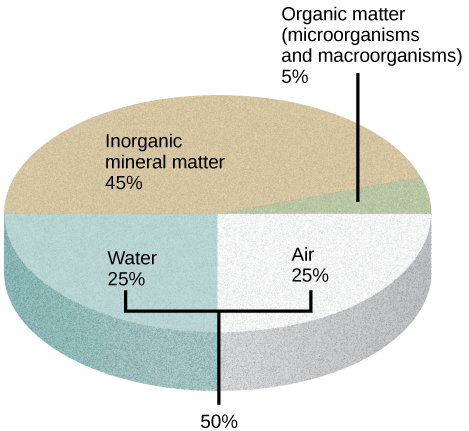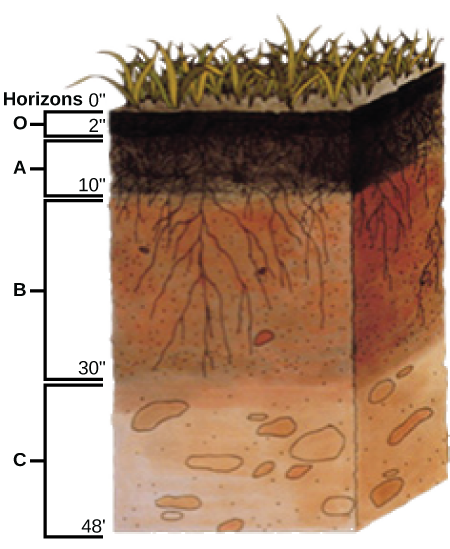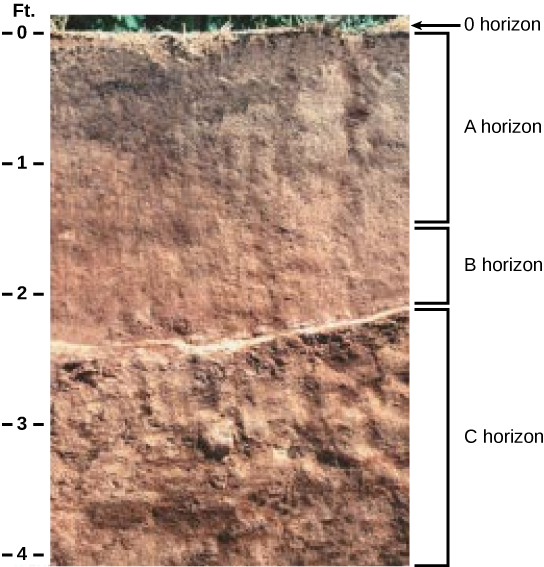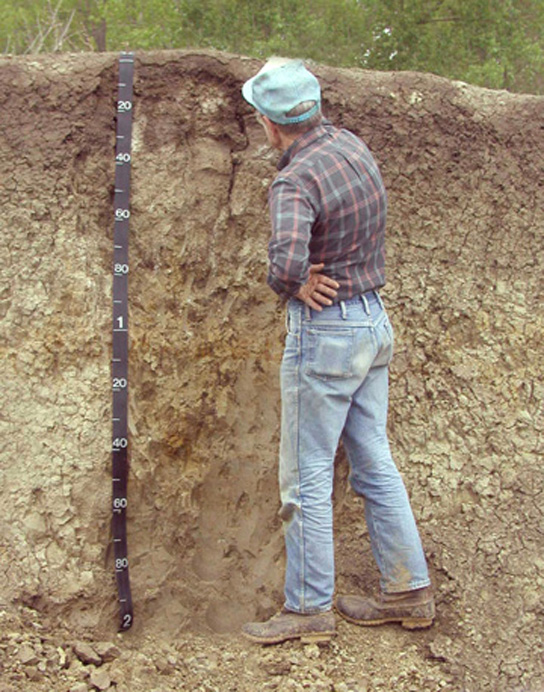
Soil compaction can result when soil is compressed by heavy machinery or even foot traffic. How might this compaction change the soil composition?
By the end of this section, you will be able to:
Plants obtain inorganic elements from the soil, which serves as a natural medium for land plants. Soil is the outer loose layer that covers the surface of Earth. Soil quality is a major determinant, along with climate, of plant distribution and growth. Soil quality depends not only on the chemical composition of the soil, but also the topography (regional surface features) and the presence of living organisms. In agriculture, the history of the soil, such as the cultivating practices and previous crops, modify the characteristics and fertility of that soil.
Soil develops very slowly over long periods of time, and its formation results from natural and environmental forces acting on mineral, rock, and organic compounds. Soils can be divided into two groups: organic soils are those that are formed from sedimentation and primarily composed of organic matter, while those that are formed from the weathering of rocks and are primarily composed of inorganic material are called mineral soils. Mineral soils are predominant in terrestrial ecosystems, where soils may be covered by water for part of the year or exposed to the atmosphere.
Soil consists of these major components ([link]):
The amount of each of the four major components of soil depends on the amount of vegetation, soil compaction, and water present in the soil. A good healthy soil has sufficient air, water, minerals, and organic material to promote and sustain plant life.

Soil compaction can result when soil is compressed by heavy machinery or even foot traffic. How might this compaction change the soil composition?
The organic material of soil, called humus, is made up of microorganisms (dead and alive), and dead animals and plants in varying stages of decay. Humus improves soil structure and provides plants with water and minerals. The inorganic material of soil consists of rock, slowly broken down into smaller particles that vary in size. Soil particles that are 0.1 to 2 mm in diameter are sand. Soil particles between 0.002 and 0.1 mm are called silt, and even smaller particles, less than 0.002 mm in diameter, are called clay. Some soils have no dominant particle size and contain a mixture of sand, silt, and humus; these soils are called loams.
 Explore this interactive map from the USDA’s National Cooperative Soil Survey to access soil data for almost any region in the United States.
Explore this interactive map from the USDA’s National Cooperative Soil Survey to access soil data for almost any region in the United States.
Soil formation is the consequence of a combination of biological, physical, and chemical processes. Soil should ideally contain 50 percent solid material and 50 percent pore space. About one-half of the pore space should contain water, and the other half should contain air. The organic component of soil serves as a cementing agent, returns nutrients to the plant, allows soil to store moisture, makes soil tillable for farming, and provides energy for soil microorganisms. Most soil microorganisms—bacteria, algae, or fungi—are dormant in dry soil, but become active once moisture is available.
Soil distribution is not homogenous because its formation results in the production of layers; together, the vertical section of a soil is called the soil profile. Within the soil profile, soil scientists define zones called horizons. A horizon is a soil layer with distinct physical and chemical properties that differ from those of other layers. Five factors account for soil formation: parent material, climate, topography, biological factors, and time.
The organic and inorganic material in which soils form is the parent material. Mineral soils form directly from the weathering of bedrock, the solid rock that lies beneath the soil, and therefore, they have a similar composition to the original rock. Other soils form in materials that came from elsewhere, such as sand and glacial drift. Materials located in the depth of the soil are relatively unchanged compared with the deposited material. Sediments in rivers may have different characteristics, depending on whether the stream moves quickly or slowly. A fast-moving river could have sediments of rocks and sand, whereas a slow-moving river could have fine-textured material, such as clay.
Temperature, moisture, and wind cause different patterns of weathering and therefore affect soil characteristics. The presence of moisture and nutrients from weathering will also promote biological activity: a key component of a quality soil.
Regional surface features (familiarly called “the lay of the land”) can have a major influence on the characteristics and fertility of a soil. Topography affects water runoff, which strips away parent material and affects plant growth. Steeps soils are more prone to erosion and may be thinner than soils that are relatively flat or level.
The presence of living organisms greatly affects soil formation and structure. Animals and microorganisms can produce pores and crevices, and plant roots can penetrate into crevices to produce more fragmentation. Plant secretions promote the development of microorganisms around the root, in an area known as the rhizosphere. Additionally, leaves and other material that fall from plants decompose and contribute to soil composition.
Time is an important factor in soil formation because soils develop over long periods. Soil formation is a dynamic process. Materials are deposited over time, decompose, and transform into other materials that can be used by living organisms or deposited onto the surface of the soil.
Soils are named and classified based on their horizons. The soil profile has four distinct layers: 1) O horizon; 2) A horizon; 3) B horizon, or subsoil; and 4) C horizon, or soil base ([link]). The O horizon has freshly decomposing organic matter—humus—at its surface, with decomposed vegetation at its base. Humus enriches the soil with nutrients and enhances soil moisture retention. Topsoil—the top layer of soil—is usually two to three inches deep, but this depth can vary considerably. For instance, river deltas like the Mississippi River delta have deep layers of topsoil. Topsoil is rich in organic material; microbial processes occur there, and it is the “workhorse” of plant production. The A horizon consists of a mixture of organic material with inorganic products of weathering, and it is therefore the beginning of true mineral soil. This horizon is typically darkly colored because of the presence of organic matter. In this area, rainwater percolates through the soil and carries materials from the surface. The B horizon is an accumulation of mostly fine material that has moved downward, resulting in a dense layer in the soil. In some soils, the B horizon contains nodules or a layer of calcium carbonate. The C horizon, or soil base, includes the parent material, plus the organic and inorganic material that is broken down to form soil. The parent material may be either created in its natural place, or transported from elsewhere to its present location. Beneath the C horizon lies bedrock.

Which horizon is considered the topsoil, and which is considered the subsoil?
Some soils may have additional layers, or lack one of these layers. The thickness of the layers is also variable, and depends on the factors that influence soil formation. In general, immature soils may have O, A, and C horizons, whereas mature soils may display all of these, plus additional layers ([link]).

Soil ScientistA soil scientist studies the biological components, physical and chemical properties, distribution, formation, and morphology of soils. Soil scientists need to have a strong background in physical and life sciences, plus a foundation in mathematics. They may work for federal or state agencies, academia, or the private sector. Their work may involve collecting data, carrying out research, interpreting results, inspecting soils, conducting soil surveys, and recommending soil management programs.

Many soil scientists work both in an office and in the field. According to the United States Department of Agriculture (USDA): “a soil scientist needs good observation skills to analyze and determine the characteristics of different types of soils. Soil types are complex and the geographical areas a soil scientist may survey are varied. Aerial photos or various satellite images are often used to research the areas. Computer skills and geographic information systems (GIS) help the scientist to analyze the multiple facets of geomorphology, topography, vegetation, and climate to discover the patterns left on the landscape.”1 Soil scientists play a key role in understanding the soil’s past, analyzing present conditions, and making recommendations for future soil-related practices.
Plants obtain mineral nutrients from the soil. Soil is the outer loose layer that covers the surface of Earth. Soil quality depends on the chemical composition of the soil, the topography, the presence of living organisms, the climate, and time. Agricultural practice and history may also modify the characteristics and fertility of soil. Soil consists of four major components: 1) inorganic mineral matter, 2) organic matter, 3) water and air, and 4) living matter. The organic material of soil is made of humus, which improves soil structure and provides water and minerals. Soil inorganic material consists of rock slowly broken down into smaller particles that vary in size, such as sand, silt, and loam.
Soil formation results from a combination of biological, physical, and chemical processes. Soil is not homogenous because its formation results in the production of layers called a soil profile. Factors that affect soil formation include: parent material, climate, topography, biological factors, and time. Soils are classified based on their horizons, soil particle size, and proportions. Most soils have four distinct horizons: O, A, B, and C.
[link] Soil compaction can result when soil is compressed by heavy machinery or even foot traffic. How might this compaction change the soil composition?
[link] The air content of the soil decreases.
[link] Which horizon is considered the topsoil, and which is considered the subsoil?
[link] The A horizon is the topsoil, and the B horizon is subsoil.
Which factors affect soil quality?
D
Soil particles that are 0.1 to 2 mm in diameter are called ________.
A
A soil consists of layers called ________ that taken together are called a ________.
B
What is the term used to describe the solid rock that lies beneath the soil?
B
Describe the main differences between a mineral soil and an organic soil.
A mineral soil forms from the weathering of rocks; it is inorganic material. An organic soil is formed from sedimentation; it mostly consists of humus.
Name and briefly explain the factors that affect soil formation.
Parent material, climate, topography, biological factors, and time affect soil formation. Parent material is the material in which soils form. Climate describes how temperature, moisture, and wind cause different patterns of weathering, influencing the characteristics of the soil. Topography affects the characteristics and fertility of a soil. Biological factors include the presence of living organisms that greatly affect soil formation. Processes such as freezing and thawing may produce cracks in rocks; plant roots can penetrate these crevices and produce more fragmentation. Time affects soil because soil develops over long periods.
Describe how topography influences the characteristics and fertility of a soil.
Topography affects water runoff, which strips away parent material and affects plant growth. Steeps soils are more prone to erosion and may be thinner than soils that are on level surfaces.

You can also download for free at http://cnx.org/contents/185cbf87-c72e-48f5-b51e-f14f21b5eabd@11.2
Attribution: